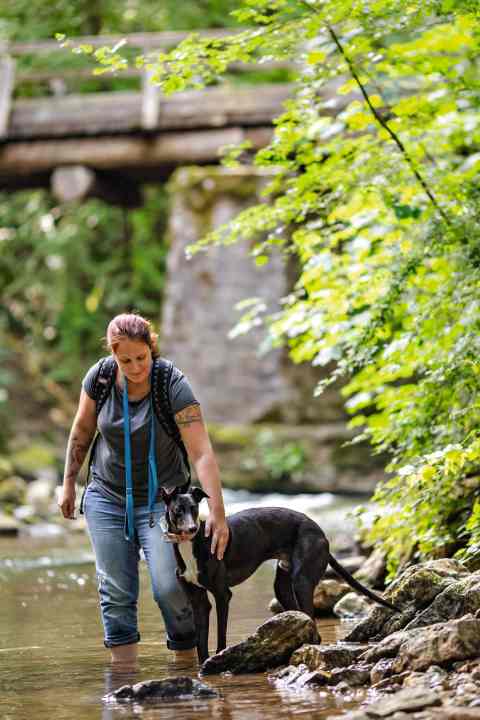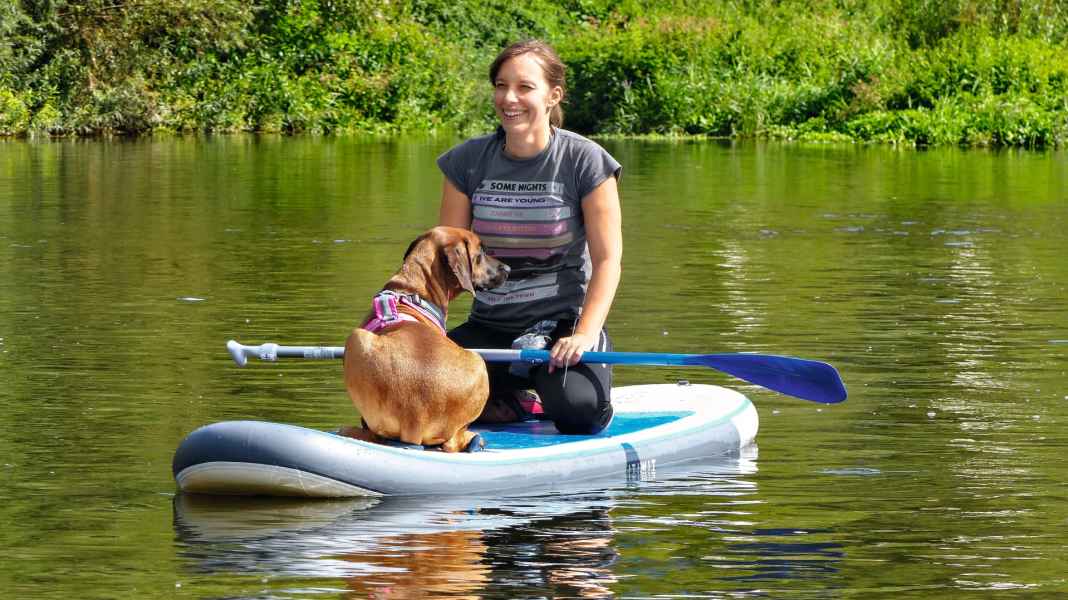
Stand up paddling with dogs has long been popular with many dog owners and is enjoying great popularity - and rightly so! The animal combo combines so much: fitness training for humans and animals, dog training, an intensive time together on the water, bonding and also strengthening self-confidence. Before humans and dogs can start their joint adventure on the water, it makes sense to make a few preparations.
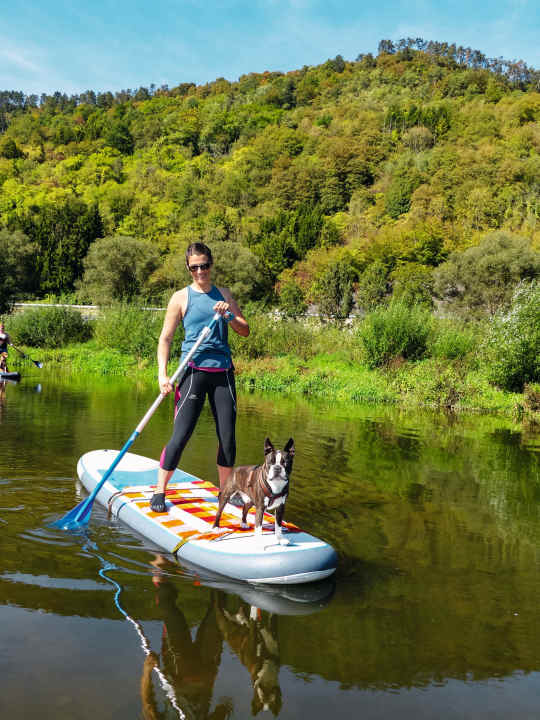
What do you need to start "SUP with a dog"?
Basically, you can use your normal SUP equipment. At this point, I would just like to explain what additional things you need to consider or what equipment is required if you take your dog on board with you.
Important! If you don't have your own SUP board, check with the SUP hire company beforehand whether dogs are allowed on board. This is by no means a matter of course, as dogs' claws can cause damage to the board. As many SUP hire centres resell the boards at the end of the season, this naturally reduces their value. You can now also find dog schools in many regions that offer "SUP with dog courses" and can provide boards for hire. Which board is suitable for SUP with a dog depends on various factors, not least the size of the dog.
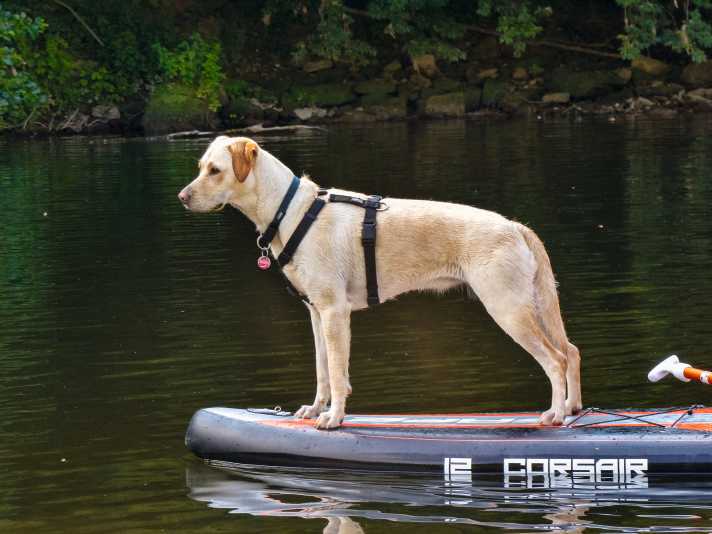
First of all, it makes the most sense to buy or hire a board with a soft deck that is as large or continuous as possible. This not only gives you a good grip, but also your dog. It reduces the risk of slipping and gives your dog (and you) stability. There are now also special SUP boards for dog owners and yoga boards, most of which are coated. Anti-slip mats can also be retrofitted.
Towels are also a good alternative to prevent damage to the board from the dog's claws. These can either simply be placed on the SUP board or fastened with straps. In my "SUP with dog courses", which I run regularly in summer together with a SUP instructor, we have often used the variant with the towels attached with straps and have been very satisfied with this simple, inexpensive and quick solution.
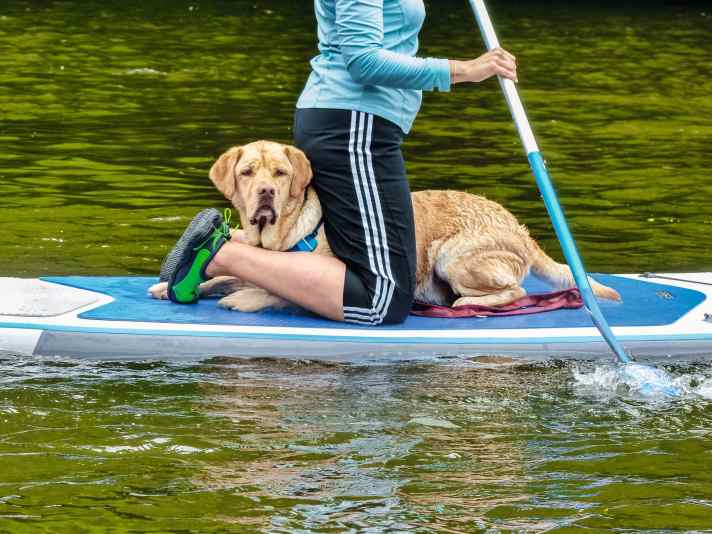
When choosing a board size, you should always take your own weight and that of your dog into account. A board width from 32'' is highly recommended for SUP with a dog, for medium to large dogs I would personally choose a board from 34''. You could say the rule of thumb applies: The bigger and heavier your dog (and yourself) is, the bigger and wider the SUP board should be. Boards that are also a little wider at the front are particularly suitable. With small dogs up to approx. 35 cm shoulder height and a maximum of 10 kg, it is usually no problem to choose a narrower board - provided that the human can ride it well and the dog also feels safe on it.
In addition to the SUP board and other equipment, there are a few additional things you need when SUPing with a dog. Your dog should wear a harness or - depending on the water, stamina and personality of the dog - a dog life jacket. Both the harness and the life jacket have the advantage that you can help your dog onto the board more easily. If your dog jumps into the water on the way or the start of the SUP tour takes place directly in slightly deeper water, you can attach your dog to the harness. Tableware or the Life jacket onto the board if it cannot do so under its own power. It's not that easy for a four-legged friend to climb onto the board from the water when swimming.
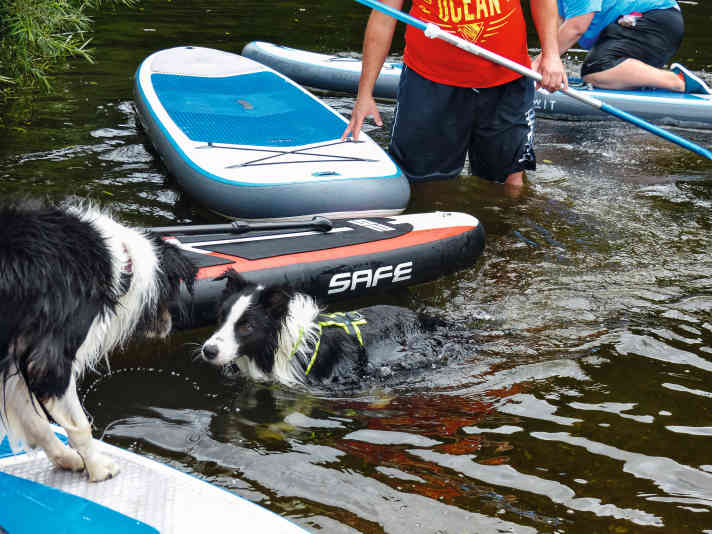
If you are travelling on larger rivers with corresponding water depth and flow speed, on large lakes or in the sea SUP with a dog, I personally recommend putting a life jacket on your dog. It's easy to underestimate the distances that have to be travelled by swimming and there is always a residual risk that your dog won't swim back to your board after jumping into the water, but will get scared and want to swim ashore due to some unforeseeable stimuli, for example. Dogs, like humans, can of course get into emergency situations.
Another great tool - especially if you need to introduce your dog to SUP boards in the water - is an anchor.
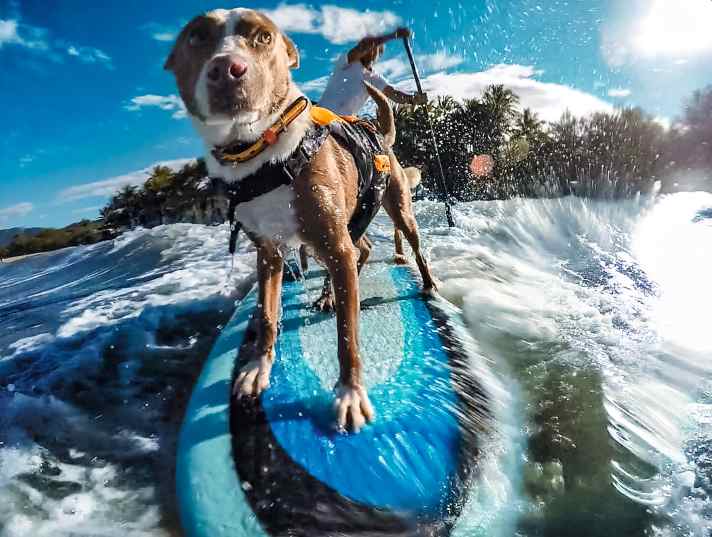
Travelling as a human-dog team on the SUP board.
Once you have the necessary equipment, you need to find a suitable body of water where you can start. A standing body of water such as a lake or a calm, shallow river is particularly suitable for your first paddle tours with a dog, but this doesn't mean that you can't start by the sea. This mainly depends on how experienced you are with the SUP, how confident you feel and, above all, on your dog's personality. If your dog is easily distracted, it may be a good idea to choose a place where there isn't too much hustle and bustle to begin with. That way, you can concentrate on each other and on the SUP adventure together.
Before you start with your dog, you should first familiarise yourself with the SUP board, paddling techniques and the like. So if you don't have any experience with the SUP, you should start without your dog so that you are more confident and can take your four-legged friend on board with you. Of course, you don't have to be a complete professional, but you should be able to
- safely get on and off the SUP board in the water,
- to be able to ride straight ahead on the selected body of water without difficulty,
- tack the SUP board without any problems and
- to stop.
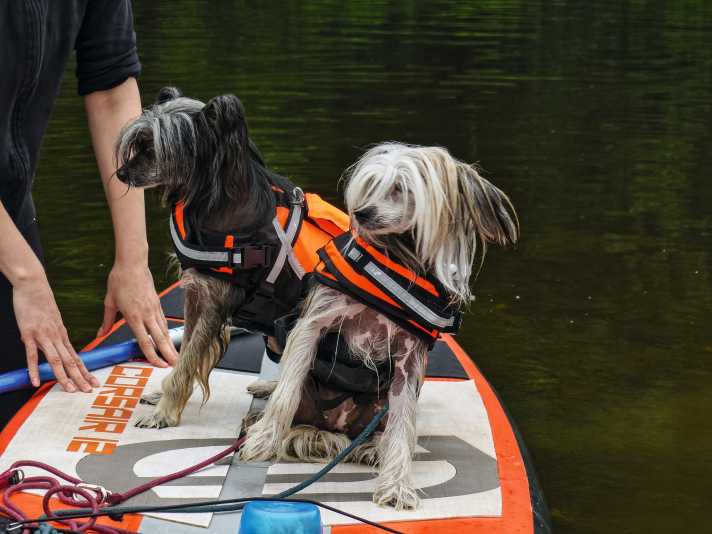
If you still feel insecure with these basic skills and at the same time have to look after your dog and want to give them confidence, you may only be making your hobby together unnecessarily difficult.
Paddling with dogs offers an excellent opportunity not only to engage in sporting activities with your dog, but also to promote bonding and trust. Experiencing adventures together strengthens the relationship! Dogs are different - just like people - so there is no one-size-fits-all recipe for how dogs should best be introduced to this shared hobby. There are dogs that get straight on the board with you and you can paddle off as if you've never done anything else. And there are dogs that are initially unsure, very excited or find it difficult to get started together with their human for other reasons. If in doubt, I recommend attending a "SUP with dog course" to get professional support.
If you have several dogs, it makes sense to introduce them to SUP with a dog one at a time before you take several dogs onto the SUP board. Incidentally, experience has shown that whether your dog likes water or not is not so important. Sometimes it can even be easier if your dog is not an extreme water rat and constantly wants to jump into the water from the board.
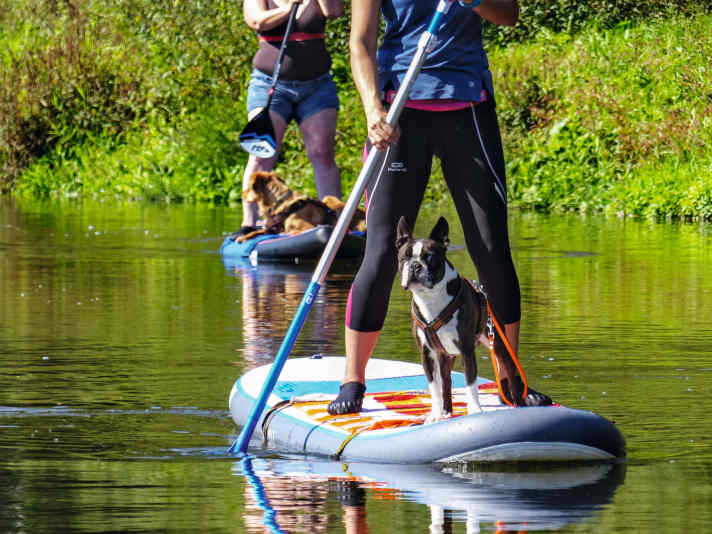
If your dog is not yet familiar with SUP, the following procedure makes sense:
- You prepare the SUP board on land for your excursion together, i.e. you protect it with an anti-slip mat or towels if necessary and remove the fin first. Then show your dog the board and let him get on and off on land. For larger dogs - which will have less room to move around on the board with you - it can also make sense to assign them a place on the board that they should also occupy on the water afterwards.
- You create the right conditions by choosing a suitable body of water for your first trip together. In practice, it has proven to be a good idea to attach the board to an anchor in the water and then get on the board together with your dog without having to worry about drifting off or having to reach for the paddle straight away. Alternatively, a second person can hold on to the board and stabilise it a little when getting on - especially with large dogs. If your own dog is a little unsure at first, you can simply sit on the board with him.
- As soon as you and your dog feel confident, you can either dip the paddle into the water to the right or left of you while sitting - without moving off. Dogs react differently when the paddle is used, so simply give your dog the opportunity to adjust to this new situation first. You can also stand up and "pseudo-paddle".
- When you realise that your dog is ready, release the board from the anchor and off you go!
Some dogs need a little time at the beginning to get used to the new situation. For some four-legged friends, it can also be helpful to playfully incorporate a few tricks to learn to balance themselves better. From giving paws to running a figure eight around the legs of the human standing on the board, everything is possible here - if there is enough space on the board.
My experience is that, with a little patience, it is possible to go for a short paddle with any dog the first time. With some dogs, it may be that you as a human first spend time sitting or kneeling.
If you start with your dog, make sure that you don't overstrain him. Dogs also have to balance themselves well when stand up paddling - depending on their condition, this can be very strenuous.
In principle, you can go on tours with your dog for up to 60 minutes, but you can also go on day tours - provided there is enough time for people and dogs to recover.
How physically demanding a dog is depends on various factors. Whether the dog is standing on the board, lying down, running around and swimming in between - all of these factors naturally influence how long you can spend travelling with your dog. SUP is also physical fitness training for dogs and can therefore even be used in physiotherapy to build up muscles and promote balance. It is therefore essential to consider the fitness level of your four-legged friend. If health restrictions or weak points in the dog's musculoskeletal system are known, a consultation with a veterinary surgeon or a dog physiotherapist should take place.
Don't be alarmed: With some dogs, the muscles in their legs start to tremble after a short time on the SUP board - which can also be the case with us when we are under strain. This is not normally a medical problem, but you should be careful not to overexert the muscles and take a regeneration break as soon as possible.
For me, SUP with a dog is a wonderful opportunity to enjoy the outdoors with my dog and get some exercise.
The author:
Verena Helfrich is an educator and dog trainer and runs her dog school PudelsKern in Luxembourg. She has been offering "SUP with dog courses" since 2018 and has already accompanied several human-dog teams on their first outings on the water. She lives with her husband, three dogs and various other animals near Trier / Germany.
Website: www.pudelskern.dog
